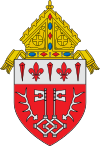Frederick Eis | |
|---|---|
| Bishop of Sault Sainte Marie-Marquette titular bishop of Bita | |
 | |
| Church | Roman Catholic Church |
| See | Diocese of Sault Sainte Marie-Marquette |
| In office | August 20, 1899 to July 8, 1922 |
| Predecessor | John Vertin |
| Successor | Paul Joseph Nussbaum |
| Orders | |
| Ordination | October 30, 1870 by Ignatius Mrak |
| Consecration | August 20, 1899 by Frederick Katzer |
| Personal details | |
| Born | January 20, 1843 |
| Died | May 5, 1926 (aged 83) Marquette, Michigan, United States |
| Nationality | German |
| Education | St. Francis Seminary College of Jolliette |
Frederick Eis (January 20, 1843 – May 5, 1926) was a German-born prelate of the Roman Catholic Church. He served as bishop of the Diocese of Sault Sainte Marie-Marquette in the Upper Peninsula of Michigan from 1899 to 1922.
Biography
Early life
Frederick Eis was born in Arbach, then in the Rhine Province of the Kingdom of Prussia, part of the German Empire (present day Germany). He was the youngest of four children of William Eis and Catherine Dietrich.[1] When Eis was age 12, his family emigrated to the United States in 1855. They settled first in Calvary, Wisconsin, then Minnesota and finally in Rockland, Michigan.[1] Eis was taught Latin and French by a missionary priest, Martin Fox.[2][3]
In 1861, Eis began his studies for the priesthood at St. Francis Seminary in Milwaukee, Wisconsin.[4] Due to the American Civil War, Bishop Frederic Baraga sent Eis to study philosophy and theology instead at the College of Joliette in Joliette, Quebec.[5] During his final years at Joliette, he taught English, mathematics and commerce.[1]
Priesthood
Eis was ordained a priest by Bishop Ignatius Mrak on October 30, 1870, for the Diocese of Sault Sainte Marie and Marquette.[6] After his ordination, Eis served in the following parishes in Michigan:
- Rector of St. Peter Cathedral Parish in Marquette (1870 to 1873)[1]
- Pastor of Sacred Heart Parish in Calumet, (1873 to 1874)
- Pastor of St. Anne Parish in Hancock (1874 to 1880)[2]
- Pastor at St. Paul Parish in Negaunee (1880 to 1890). While at St. Paul, he reduced the parish's debt and built a school. He was forced to resign in 1890 due to health problems.[3]
For the next five years, to improve his health, Eis spent his winters in California and Colorado, returning to Michigan in the summer.[1] After his health improved, he was appointed pastor of St. Sebastian Parish in Bessemer, Michigan, in 1894, then moved in 1895 to Guardian Angels Parish in Crystal Falls, Michigan, to serve as pastor.[2] During this period, Eis served as the inspector of the diocesan schools. After the death of Bishop John Vertin, Eis served as diocesan administrator.[3][1]
Bishop of Sault Sainte Marie and Marquette
On June 7, 1899, Eis was appointed the fourth bishop of the Diocese of Sault Sainte Marie and Marquette by Pope Leo XIII.[6] He received consecration on August 20, 1899, from Archbishop Frederick Katzer at St. Peter Cathedral.[6]
During Eis' 23-year tenure as bishop, he led the diocese through the nationalist controversies within the American Catholic community, and founded several charitable institutions and hospitals.[7] He was known for being helpful to men wanting to enter seminary and women wanting to join religious orders.[3]In 1900, Eis travelled to Rome, meeting with Leo XIII at the Vatican.[1]
Retirement and legacy
On July 8, 1922, Pope Pius XI accepted Eis' resignation as bishop of the Diocese of Sault Sainte Marie and Marquette and appointed him as titular bishop of Bita and an assistant at the pontifical throne.[6]
Frederick Eis died in Marquette on May 5, 1926, at age 83.[8] He is buried in the bishops' crypt at St. Peter Cathedral.[7]
Notes
- ^ a b c d e f g Rezek, Antoine Ivan (1906). History of the Diocese of Sault Ste, Marie and Marquette: Containing a Full and Accurate Account of the Development of the Catholic Church in Upper Michigan, with Portraits of Bishops, Priests and Illustrations of Churches Old and New. na.
- ^ a b c Walling, Regis M., ed. (1990). The Diary of Bishop Frederic Baraga: First Bishop of Marquette, Michigan. N. Daniel Rupp. Detroit: Wayne State University Press.
- ^ a b c d Men of Progress: Embracing Biographical Sketches of Representative Michigan Men. Evening news association. 1900.
- ^ O'Donnell, John Hugh (1922). The Catholic Hierarchy of the United States, 1790-1922. Washington, D.C.
{{cite book}}: CS1 maint: location missing publisher (link) - ^ Rezek, Antoine Ivan (1910). "Diocese of Marquette". Catholic Encyclopedia. Vol. IX. New York: Robert Appleton Company.
- ^ a b c d Cheney, David M. "Bishop Frederick Eis". Catholic-Hierarchy.org.
- ^ a b "12 bishops have led the diocesan church". Roman Catholic Diocese of Marquette. Archived from the original on July 26, 2011. Retrieved February 22, 2023.
- ^ "Former Marquette Bishop Dies at 83". The True Voice. N.C.W.C. News Service. May 14, 1926. p. 1. Retrieved February 22, 2023 – via Newspapers.com.

